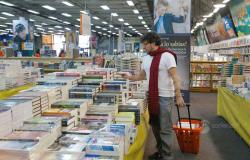
Álvaro Pinteño (Ronda, 30 years) tells that he also suffered chronic pain, a problem that affects about 20% of people. His experience helped him understand the complexity of the phenomenon, how social and psychological circumstances, beyond the physical origin of suffering, must be included in the equation to seek solutions to the problem. In his book J*der, how it hurts! (ARPA), recently published, Pinteño offers a guide to better understand pain through his personal experience, as a professional and as a patient, guiding us along a path that avoids simplistic explanations and sharp solutions.
In an interview conducted in person in Madrid, he acknowledges that he – very active in social networks – fell tempting to offer those advice that operates so well among the public. “At a higher level of ignorance, you will show you safer,” says Pinteño, who knows that “the most attractive messages, and of those who echo the most people, are the simplest.” Now, it offers much more nuanced interpretations, with many references to scientific studies and a message of hope: even if it is not easy, it is possible to get rid of chronic pain or, at least, live well with him.
Ask. What do we understand badly about pain?
Answer. It is thought that if something hurts, there must be an organic cause that justifies it. In most cases it will be so, especially with the most acute pain, but when the pain is more chronic and persists, the image tests do not give us the answers we are looking for and we begin to think that there may be another serious cause or something that is being overlooked. And the therapeutic pilgrimage begins, and false diagnoses and interventionism appear that does not take into account failed solutions, in which the professional thinks that he will do better than others and will find a solution.
But in chronic pain it is rather to know what it is not, to reach knowledge by subtraction, knowing what should not be done. Many times the patient thinks that there is something wrong with his body, but often it is more an adaptation of the organism to the environment in which the person who reinforces many dysfunctional behaviors of coping of pain is unfolded, which is what we deal with in consultation.
P. A very common idea about the work of the physiotherapist is that they give massages that take away pain. What is the real work of the physiotherapist?
R. What we do is help patients actively face the problem that produces pain. We give tools to know what they have to do when they have pain, when they have a relapse. So that he knows that in many cases in the course of 48 or 72 hours the pain is usually disappear on his own and that he wins that security and that cognitive flexibility to live with pain and improve his quality of life.
P. Sometimes treatments such as placebo are given, so that the person has the feeling that he has been paid attention, because if nothing was given, he would be unsatisfied.
R. There is a very important concept, especially in patients with chronic pain, which is disdiagnosis. You find patients who come to consult with a folder full of reports and the purpose of a diagnosis is to give an explanation and show tranquility and hope. I encourage you to take enough time to, of all the reports that this patient has, discard those who are not fulfilling that task. There comes a point where patients identify with their diagnostic label and that is disabled. His identity is that of a suffering body.
For a physiotherapist, the most difficult is to do nothing and explain why. It is hard to be the first person who proposes not to continue offering failed solutions, even if the patient demands it, and having that awkward conversation about all those reports and how we are going to rename the situation. Now, my patients usually know where they come, but at first I had to lose the fear of losing patients for having that conversation.
P. Now there are many more chances of obtaining information through all kinds of tests and many more treatments. Is that positive?
R. We thought that with the advance of technology and with the rise of knowledge we would have better interventions, but what has increased is iatrogenesis [el daño que produce un tratamiento médico]overdiagnosis and naive over -interventionism. Medicalization has not caused people to have fewer pains, sometimes it has even reached addiction problems, as with opioids.
P. How can it be improved?
R. Everything goes through a good medical history, an adequate assessment of the case, seeing what are the psychosocial factors that influence, including the experience of pain, where it hurts, how it hurts and what are the characteristics of pain. What beliefs, emotions and thoughts do you have in relation to pain and how it affects you when you move. Many times we think we can’t start working without a reason; When, once a serious pathology is discarded, the important thing is not why, but how the problem works. From that information, I try for the patient to have an idea of what is happening. It is an inevitable drive between individual and collective responsibility.
P. He has once said that there are healthy doses of pain.
R. Today we are losing the ability to experience healthy doses of pain, because we have immediate solutions practically for everything. If we are hungry, we ask for a glovo, we can see the movie we want at the moment, and the minimum sensation of discomfort I can take a drug. It is also because I have to produce continuously and I cannot feel bad, because if I take a work decline, it increases the risk of saying goodbye to me. Today, at the time a nuisance appears, we are looking for in doctor Google And we self -medicate.
Pain is not an exclusive problem of the individual. You have some responsibility for what happens in your life, but there is also a collective responsibility. There are some charges in life for which there is no medication or intervention and pain, sometimes, it may have to do with the environment or it may have to do with psychosocial factors that are not the responsibility of the physiotherapist.
P. With physiotherapy something similar to psychology happens. They are very necessary therapies for many people, but they are difficult to access through public Health. Can something be done to improve this situation?
R. In Spain, the Valladolid pain of active coping unit is a reference and works from the public system to offer solutions that are often only available in the private sphere. In the treatment of these problems from the public there is what is known as the Inverse Care Law. Those who most need help are the ones who receive it less, because they are worse, and their space is occupied by people who have more capacity or more will to complain. And then there is a problem that sometimes image tests in public health are required that the guides do not recommend, unless there is suspicion of serious pathology. But it is a very complex matter for which I do not have a solution.
P. What do you think would have to change in physiotherapy?
R. We have a problem with iatrogenesis, which there are studies that say it is the third cause of death in the US. We deal with many consequences that could have been avoided. There are studies in which 79% of the sample psychiatrists say they would not take the medication they guide their patients, and that they would prefer a more conservative attitude. Health system incentives push to intervene, even when it is not necessary. For years, overintervine patients with invasive therapies who would not apply myself; And many colleagues, in private, recognize the same. The fundamental principle must be first, not harm. We should be more careful.





